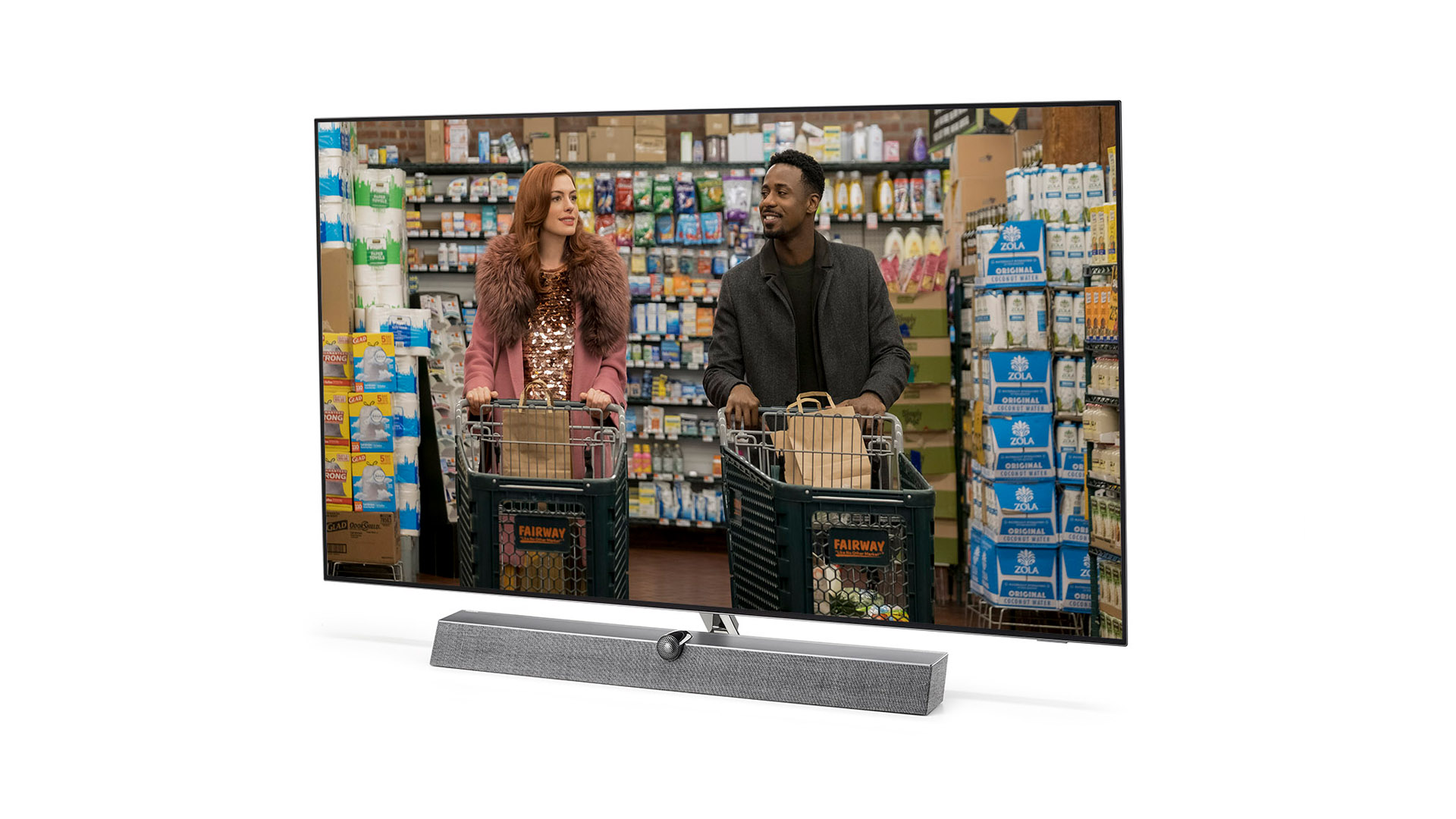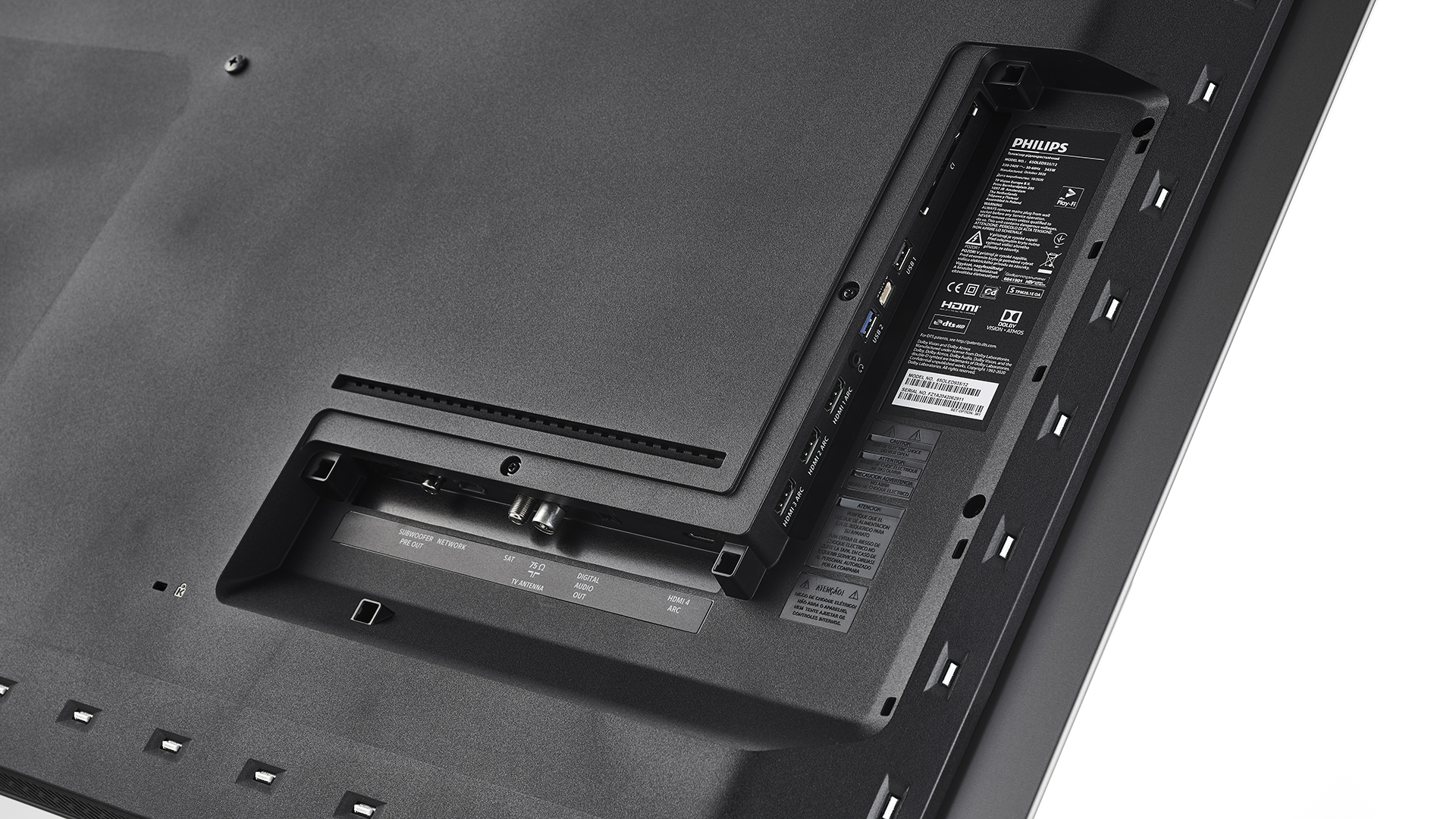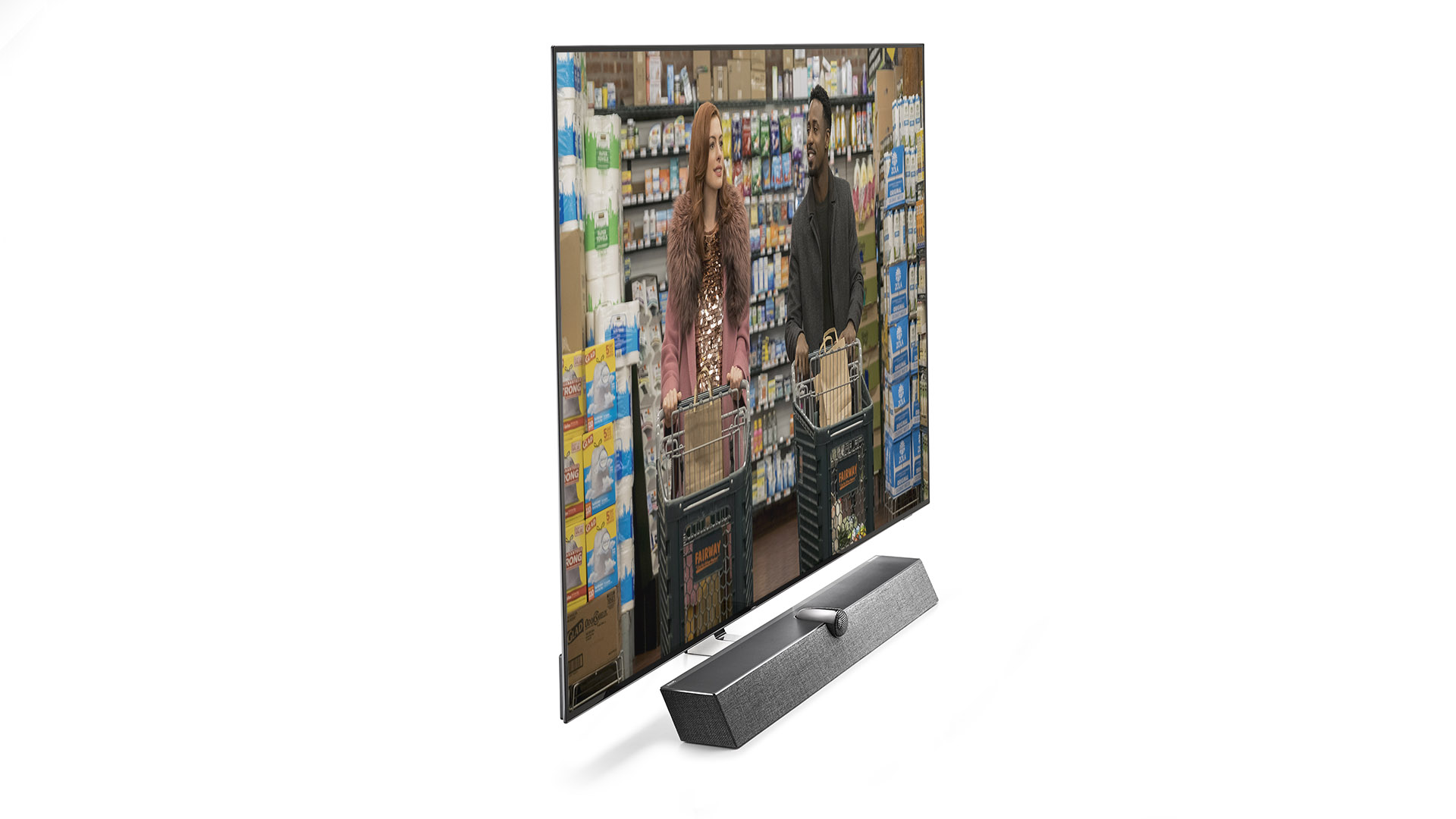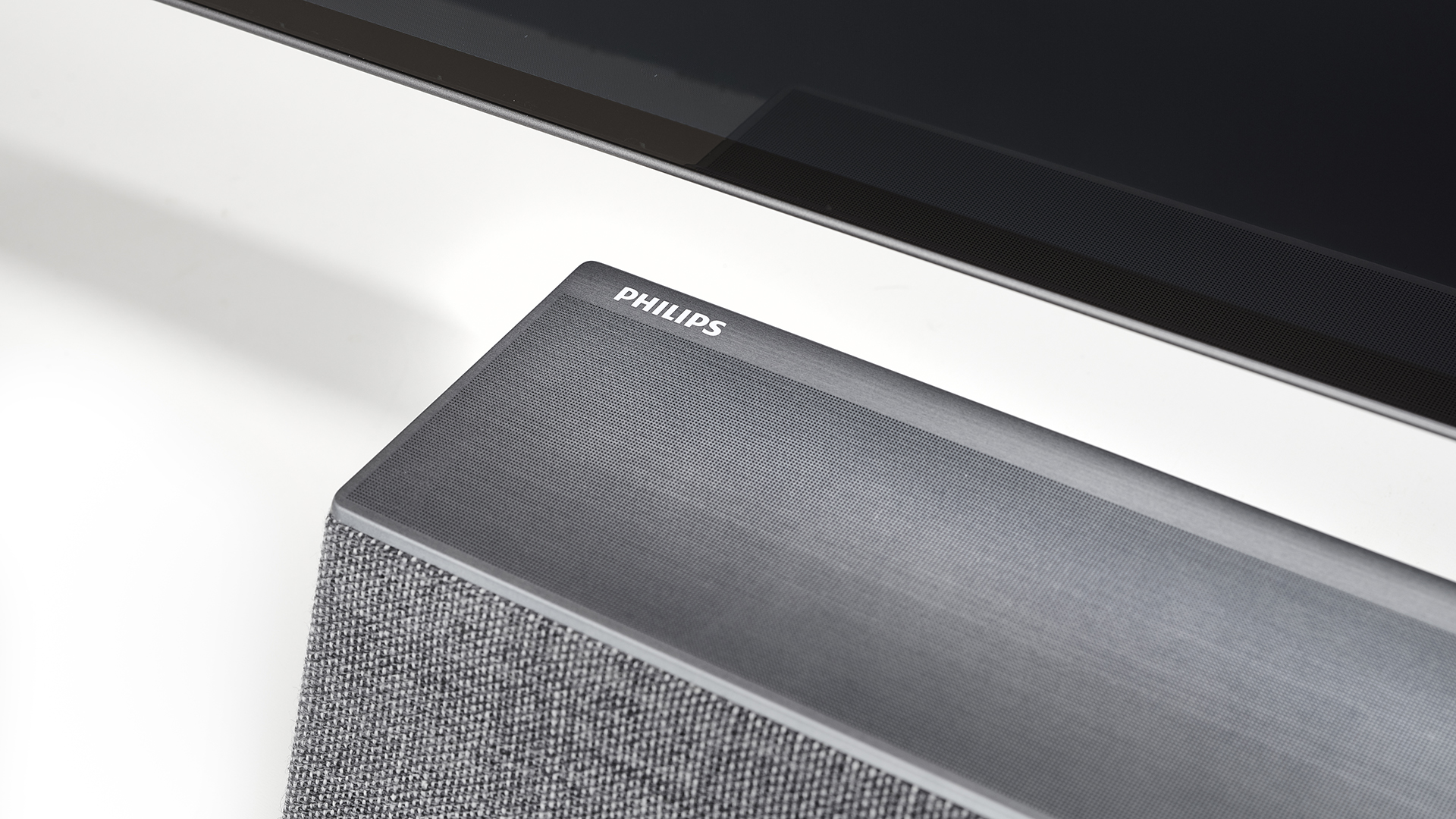What Hi-Fi? Verdict
Philips has produced a brilliant OLED television, but the partnering soundbar isn't quite at the same level
Pros
- +
Tidy and appealing build
- +
Punchy HDR and SDR pictures
- +
Fabulous 4K detail
Cons
- -
UI a little dated
- -
Mediocre motion processing
- -
Sonically short on dynamics
Why you can trust What Hi-Fi?
Combining a television with an integrated soundbar can be a double-edged sword. It’s the height of TV sound convenience, but unless the soundbar is top quality, then you’re stuck with it. Enter the Philips 65OLED935 – a sleek, powerful television that aims to get around this inherent pitfall by having hi-fi specialist Bowers & Wilkins design and build the speaker system.
This isn’t Philips’s first combined television and soundbar. The company's 2019 flagship OLED, the OLED934, was a similar creature, but with a far bigger Bowers bar built into a large floor stand. It proved to be a match made in AV heaven, so why break up the partnership?
This time, looks and price tag are considerably more modest, but its fresh take on the 3.1.2ch Dolby Atmos soundbar design makes this a tempting solution for those who like to keep things simple to use and easy on the eye.
But to describe the Philips 65OLED935 in those terms alone is doing it a disservice. Underneath that sculpted steel exterior, there is a TV with impressive specs that could even outperform its soundbar-less sibling, the five-star-rated Philips 65OLED805.
Now with a dual AI engine inside its top-of-the-line P5 processor, Philips is confident enough to describe the performance of the 935 as “OLED+”.
Build


Screen OLED
Resolution 4K
Operating system Android TV 9
Speakers 10W x2, 5W, 20W (woofer), 12.5W x2 (height)
HDR formats HDR10, HLG, Dolby Vision, HDR10+
HDMI x4
USB x2
Optical output yes
Sound 3.1.2ch, 70W
Dimensions (hwd) 93 x 145 x 30cm (with stand)
Weight 34.8kg (with stand)
The Philips 65OLED935 is a classy looking set. It comes with a choice of two different chrome brackets in the box, one for wall-mounting and the other to use as a stand. The cable tidying system means that the join between the soundbar and the TV itself is seamless, leaving only your HDMI cables and power lines to tuck neatly away behind.
The stand and bracket are pretty heavy and highly polished, so take care they don’t slip out of your grasp when you’re putting this together. Fortunately, the wafer-thin OLED panel is nice and light. The stand needs a surface that’s at least 88cm wide and 26cm deep to accommodate it and if you choose to use the bracket, it stands 15cm proud of the wall.
The latest hi-fi, home cinema and tech news, reviews, buying advice and deals, direct to your inbox.
There’s little to no bezel, just an even 2mm metal bead around the edge of the glass. On the back of the panel, you’ll find four HDMI sockets. Next-gen HDMI features are thin on the ground, though: there's no support for 4K@120Hz (also known as HFR), VRR (Variable Refresh Rate) or eARC (Enhanced Audio Return Channel), although standard ARC and ALLM (Auto Low Latency Mode) do feature.
As well as the HDMIs there’s an optical audio-out, ports for connecting headphones and an external subwoofer, plus two USB slots. It’s Bluetooth-enabled for audio, too.
The soundbar houses ten separate drive units. There are two 5cm midrange cones plus a 19mm titanium-dome tweeter for the centre channel, one of the same cones and tweeters each for the left and right, and then a single racetrack-style 10cm x 6.5cm subwoofer unit on the top surface, ported to the rear. Also along that top edge are the two 5cm height speakers facing upwards for that Dolby Atmos effect.
The tweeters are decoupled from the main enclosure, with the centre one in a metal case of its own in B&W’s tweeter-on-top style. There’s a micromesh to protect those drivers on the upper surface and Philips’s acoustically transparent wool blend cloth, Kvadrat, across the front of the array.
Made from glass fibre-reinforced polycarbonate ABS, the enclosure is braced with internal rib sections to control resonance. It’s mounted to the TV with a stiff metal plate. If that sounds like an appealing level of attention to detail, you’ll also be pleased with the remote control, which is backed in Muirhead leather and feels very much the part for a premium OLED TV.
Features

Functionally, the remote is the same as we’ve had from Philips over the last few years. Much like the Android 9.0 operating system itself, all the right options are there but they're not presented in a particularly wonderful, intuitive or user-friendly fashion.
Other manufacturers such as Samsung and LG are slicker and more progressive on this front and while it’s just about acceptable here, we’d expect to see the company up its game on this front before it falls too far behind the promised UI advances from Google TV and LG’s webOS 6.0.
The benefit of the Android OS is its app offering. All the UK catch-up services are present, along with Disney+, Amazon Prime Video and Netflix. During testing, we experienced a little bit of crackling through the speakers when using the Netflix app, but restarting the app sorted that out.
There’s no Apple TV or Apple Music on Android TV. For that, you’ll need to add an Amazon Fire TV Stick, Apple TV or other media streamer. Instead, your pay-as-you-go film and TV options are Rakuten and Google Play Movies & TV, neither of which is up there with the Apple TV app. You’re better covered for sport, though, with BT Sport and Now TV both on board.
In terms of picture technology, the OLED935 gets one or two bumps over the soundbar-less OLED805 thanks to the improved Philips P5 processor with its AI dual picture engine. The big one is AI Machine Learn Sharpness, a local level picture sharpening tool that enhances the textures and patterns of specific parts of the image, rather than applying a blanket tightening up across the whole display.
Another is AI Smart Bit Enhanced 2.0, which should remove colour banding without sacrificing detail. Last, but not least, is a boost for the Philips Perfect Natural Reality processing which aims to boost standard-def material so it looks more like Full HD.
The other picture tech of note is an anti-burn-in logo detection feature, which recognises permanent screen logos, such as those of TV networks, and dampens their effect. In testing, this works very well – we try out a Dolby Atmos test disc and the bright white intensity of the Dolby logo in the corner of the screen is dropped to a level that won’t tire the pixels so rapidly.
On the sound front, the big news is the 3.1.2 speaker arrangement, the Dolby Atmos support and upmixing, and the involvement of hi-fi specialist Bowers & Wilkins. The TV is also compatible with the DTS Play-Fi hi-res streaming standard, meaning you can set-up your soundbar to work as part of a multi-room system along with any other Play-Fi-enabled kit you might own.
No review of a top-end Philips TV is complete without a tip of the hat to Ambilight. The company’s delightful LED lightshow tech comes in its four-sided variety for the OLED935. You can set it to change colour according to the on-screen image, to music or even to mimic a national flag for sporting events. It’s a great feature and long may it last.
Picture

The Philips 65OLED935 supports both Dolby Vision and HDR10+ alongside HDR10 and HLG. We see what it makes of the first of these by slotting Spider-Man: Homecoming into our 4K Blu-ray player and the results are impressive.
Using the Dolby Vision Bright setting, the upgrades to the picture quality over the Philips OLED805 are small but clear. The scene where Peter gets stuck in the Deep Storage Vault has plenty of monochrome textures, bright colours and a large depth of field, but right from the off, the Philips AI processing works alongside the Dolby metadata to make a brilliantly punchy and vivid HDR picture.
The spidey suit really pops against a nicely detailed and defined set of greys in the background. The AI Machine Learn sharpening tech enhances the textural differences between the rough raw concrete slabs of the hangar entrance, without doing the same to the soft marbling of the polished floor. There’s a strong sense of colour precision to the hero’s mustard yellow backpack and the different red and blue shades of his outfit.
All the same, we prefer Philips’ take on the film with the TV’s HDR AI preset, which is an excellent quick-fix solution for getting the most out of Dolby Vision films. This setting keeps things simple but leaves the user with the five main Philips processing modes to experiment with. Keep the Perfect Motion and Perfect Contrast settings at a minimum and you won’t go far wrong.
The HDR Personal mode squeezes every last drop of the excellent picture performance from this TV. Once balanced for brightness, the OLED Contrast slider offers the best customisation. The higher you go, the more zing you’ll add to the colours, however, you lose a little of the sense of depth to the picture.
Heading to the film’s climax, there are some healthy levels of dark detail on show alongside some lusciously deep OLED blacks. We can still make out the folds and the feel of the material of the Vulture’s leather jacket and sheepskin collar. Those details are just shy of the best LED-backed TVs, but the trade-off for those blacks is worth it here.

Philips has upped its motion processing game for its most recent TVs by adding a couple of extra modes. All the same, the actual quality of the underlying tech is similar to what we’ve found in previous years – perfectly decent, but not in the same league as the likes of Sony and Panasonic.
We prefer the light touches of either Pure Cinema or Movie mode, although many will prefer to turn the processing off altogether. Watching Peter rush to the rescue of his friends in the Washington Monument, we’re happy to put up with some judder in the faster panning shots in order to avoid the soap-opera aesthetic.
That decision is harder when watching SDR, where judder can be more significant. Viewing the opening scenes of Jack Reacher in Full HD on Blu-ray, there’s a case for setting the motion to Standard to avoid the over-processed look, although there are plenty of artefacts every time the car disappears and emerges again under overhead freeway signs.
Philips recommends its Vivid preset as a good starting point for SDR material, but you’ll need to step back quite far on most settings to get the right blend. Colour, Brightness and Sharpness should be below their halfway marks and the Perfect Natural Reality (fake HDR) and Perfect Contrast filters are best switched off.
Once stripped back, you’ll achieve a watchable picture. The overhead shot of the riverside crime scene is excellently handled. There’s a good feel to the paving stones, a believable colour palette to the nearby flowerbeds and plenty of dark detail as the uniformed SWAT team arrives on the scene. For SDR, it has a remarkably punchy look.
Watching standard-def material is obviously less of a treat, and you’ll struggle to pick up Philips’ good work on colour blending and image sharpening. No TV can work miracles, of course, but watching BBC News, the colour of the clothing appears faithful and the newsreader’s skin tone retains a natural feel.
Sound

Our expectations of TV sound are usually tempered, but here things are different. While there are small picture quality advantages of the OLED935 over the OLED805, the integrated soundbar makes up most of the difference in price.
There are plenty of sound presets to choose from, including Personal mode, which allows access to an EQ. ‘Movie’ gets our vote for the majority of our viewing. It’s not quite as clear as the AI or Original modes, but this is a speaker array with plenty of precision and we’re happy to sacrifice a little of that for the extra spatial boost.
We watch the bombing raid sequence of Unbroken in Dolby Atmos and the B&W soundbar projects an excellent soundstage, adding plenty of height and breadth to the sound. Even with our eyes closed, it’s easy to picture the planes flying across the screen and the bullets zipping by.
The agility of the drivers makes for a good separation of the effects, unveiling all the details in the clicks and clinks of the military equipment, and the creaks of the pilots’ leather jackets. But clarity isn't quite everything when it comes to great TV sound and this set-up is missing one of the other crucial ingredients – excitement.
Dynamically, there just isn't enough going on, with differences in scale between the various sounds too small to deliver much in the way of drama. Everything's rather flat and lacking in impact. We hear the bombers fly over our heads, but without that level of involvement, we’ve no urge to duck whatsoever. The bullets offer little threat from our perspective, even as the cockpit becomes riddled with bullet holes.
Similarly, voices lack expression, which sells short the tension of the sequence. The young servicemen seem all too relaxed on their mission deep into the heart of enemy territory, rocked by the lifeless pops of flack exploding just inches from their heads.
The audio from the OLED935 is clearly superior to the OLED805. You won’t struggle to hear dialogue or appreciate music with more rhythm, but the results are far less enthralling than those of even a relatively affordable soundbar, such as the Sonos Beam. Compared with a more expensive Dolby Atmos-supporting soundbar, such as the Sonos Arc, the contrast is even less flattering.
Verdict
Philips has done a superb job to make improvements on what was already a first-class picture performance with this OLED+ TV. Watch 4K material on this set, whether Dolby Vision or otherwise, and it looks stunning. The picture is sharp and colourful with deep blacks and a great level of tonal detail – however, you can get almost all of that joy with the far more affordable OLED805.
Integrating a soundbar into the design of a TV brings the expectation of audio excellence and the OLED935 doesn’t quite deliver that. While there are plenty of plus points for the spatial smarts and the coherence and clarity of the sound, there just isn’t enough impact or drama.
Ultimately, while the price gap between the two TVs remains this wide, there’s a strong case for recommending opting for the OLED805 and investing in a dedicated soundbar, such as the Sonos Arc or even the much cheaper Beam. The 935 is clearly a more elegant solution and a step up in picture quality but, currently, that comes at too high a premium.
SCORES
- Picture 5
- Sound 3
- Features 4
MORE:
Read our guide to the best OLED televisions
Read our Philips 65OLED805 review
Read our Philips 65OLED934 review
What Hi-Fi?, founded in 1976, is the world's leading independent guide to buying and owning hi-fi and home entertainment products. Our comprehensive tests help you buy the very best for your money, with our advice sections giving you step-by-step information on how to get even more from your music and movies. Everything is tested by our dedicated team of in-house reviewers in our custom-built test rooms in London, Reading and Bath. Our coveted five-star rating and Awards are recognised all over the world as the ultimate seal of approval, so you can buy with absolute confidence.

